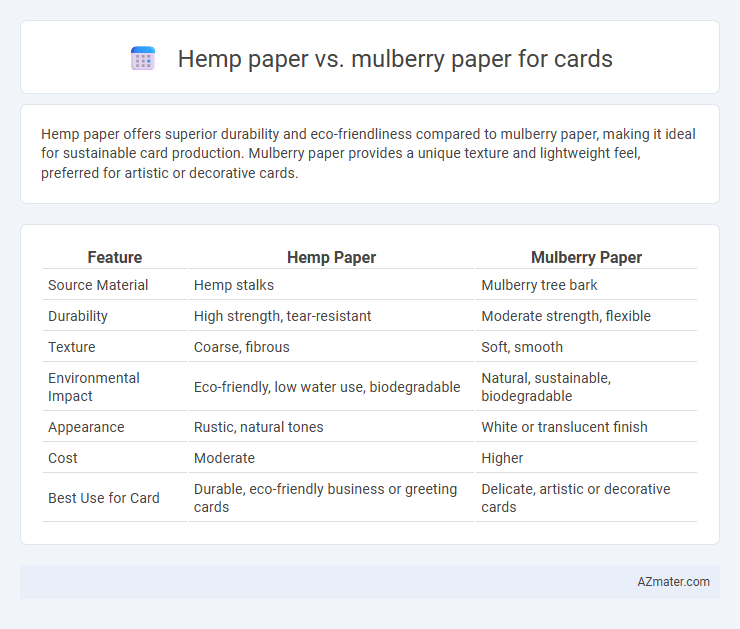Hemp paper offers superior durability and eco-friendliness compared to mulberry paper, making it ideal for sustainable card production. Mulberry paper provides a unique texture and lightweight feel, preferred for artistic or decorative cards.
Table of Comparison
| Feature | Hemp Paper | Mulberry Paper |
|---|---|---|
| Source Material | Hemp stalks | Mulberry tree bark |
| Durability | High strength, tear-resistant | Moderate strength, flexible |
| Texture | Coarse, fibrous | Soft, smooth |
| Environmental Impact | Eco-friendly, low water use, biodegradable | Natural, sustainable, biodegradable |
| Appearance | Rustic, natural tones | White or translucent finish |
| Cost | Moderate | Higher |
| Best Use for Card | Durable, eco-friendly business or greeting cards | Delicate, artistic or decorative cards |
Introduction to Hemp Paper and Mulberry Paper
Hemp paper, derived from the bast fibers of the Cannabis sativa plant, offers exceptional durability, resistance to yellowing, and eco-friendly qualities due to its sustainable cultivation and rapid growth cycle. Mulberry paper, made from the inner bark fibers of the Morus alba tree, is renowned for its smooth texture, flexibility, and traditional use in Asian art and crafts. Both papers provide unique tactile experiences and environmental benefits, making them ideal for artisanal card production with a focus on quality and sustainability.
Historical Background of Hemp and Mulberry Paper
Hemp paper has a rich history dating back over 2,000 years, originating in ancient China where it was used for early manuscripts and official documents. Mulberry paper, traditionally crafted from the inner bark of mulberry trees, has been integral to East Asian cultures, particularly in Korea and Japan, serving artistic and ceremonial purposes since at least the 7th century. Both papers played crucial roles in the development of written communication, with hemp providing durable, long-lasting fibers and mulberry paper offering unique texture and flexibility.
Production Process: Hemp Paper vs Mulberry Paper
Hemp paper production involves pulping hemp fibers that are long, strong, and require retting, followed by mechanical or chemical processing to create durable, eco-friendly sheets with minimal chemicals. Mulberry paper is traditionally made by harvesting inner bark from mulberry trees, soaking and steaming it, then manually beating the fibers to form sheets, emphasizing artisanal craftsmanship and natural texture. Both papers utilize renewable plant fibers, but hemp processing is more industrialized while mulberry paper relies heavily on manual techniques for finer, textured card applications.
Environmental Impact and Sustainability
Hemp paper offers superior environmental benefits due to its rapid growth cycle, requiring fewer pesticides and less water compared to traditional crops, making it highly sustainable for card production. Mulberry paper, sourced from the bark of Morus trees, supports sustainable forestry practices by harvesting bark without killing trees, promoting long-term ecosystem health. Both options reduce reliance on wood pulp, but hemp's higher yield per acre and faster renewability position it as a more eco-friendly choice in sustainable card manufacturing.
Texture, Appearance, and Aesthetics
Hemp paper offers a coarse, fibrous texture with natural speckles that create a rustic and organic appearance, ideal for eco-friendly cards emphasizing sustainability. Mulberry paper features a smooth yet slightly fibrous texture with visible long fibers, delivering a delicate and elegant aesthetic often favored in artisanal card designs. Both papers provide unique tactile experiences and visual appeal, with hemp paper leaning towards rugged durability and mulberry paper offering refined sophistication.
Strength and Durability Comparison
Hemp paper exhibits superior strength and durability compared to mulberry paper due to its long bast fibers, which provide enhanced tear resistance and flexibility. Mulberry paper, while smooth and aesthetically pleasing, tends to be more fragile and prone to wear under frequent handling. For card applications requiring longevity and resilience, hemp paper is the preferred choice, offering a robust structure that withstands bending and environmental stress.
Print Quality and Color Absorption
Hemp paper offers superior print quality due to its dense fiber structure, which ensures sharp image resolution and vibrant color absorption, making it ideal for detailed card designs. Mulberry paper, with its softer texture and fibrous consistency, absorbs ink more diffusely, resulting in softer, muted tones and less precise printing. For cards requiring crisp visuals and vivid colors, hemp paper provides a more reliable medium, whereas mulberry paper suits artisanal and textured effects.
Cost and Market Availability
Hemp paper generally costs more than mulberry paper due to its durable fibers and eco-friendly production, making it a premium choice for cards. Mulberry paper is widely available and often less expensive, benefiting from established supply chains in Asia where mulberry trees are abundant. Market availability for hemp paper is growing steadily but remains limited compared to the extensive distribution network of mulberry paper.
Applications: Best Uses for Card Making
Hemp paper offers exceptional durability and a natural texture ideal for eco-friendly greeting cards, invitations, and business cards that require a rustic or organic feel. Mulberry paper, with its soft fibers and translucency, excels in decorative card making, art cards, and layering techniques where visual depth and delicate aesthetics are prioritized. Both papers are favored in handmade card applications, with hemp paper suited for longevity and strength, while mulberry paper is chosen for its artistic versatility and elegant finish.
Conclusion: Choosing the Right Paper for Your Cards
Hemp paper offers exceptional durability and eco-friendliness, making it ideal for long-lasting, sustainable cards, while mulberry paper provides a delicate texture and unique fibrous appearance suitable for artistic and handmade cards. The choice depends on whether you prioritize strength and environmental impact or aesthetic appeal and traditional craftsmanship. For cards requiring robustness and a green footprint, hemp paper is preferred; for elegant, textured cards with a natural feel, mulberry paper is the better option.

Infographic: Hemp paper vs Mulberry paper for Card
 azmater.com
azmater.com